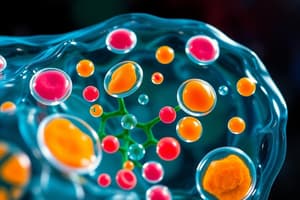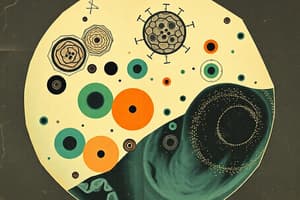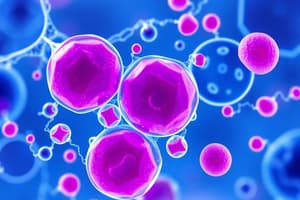Podcast
Questions and Answers
What is the primary characteristic that distinguishes eukaryotic cells from prokaryotic cells?
What is the primary characteristic that distinguishes eukaryotic cells from prokaryotic cells?
- Eukaryotic cells contain membrane-bound organelles. (correct)
- Eukaryotic cells are smaller than prokaryotic cells.
- Eukaryotic cells reproduce through binary fission.
- Eukaryotic cells lack a cell membrane.
Which statement best describes the function of the cell membrane?
Which statement best describes the function of the cell membrane?
- The cell membrane allows all substances to freely enter and exit the cell.
- The cell membrane acts as a rigid barrier to protect the cell.
- The cell membrane is primarily composed of DNA and proteins.
- The cell membrane selectively controls what enters and exits the cell. (correct)
How does active transport differ from passive transport?
How does active transport differ from passive transport?
- Active transport moves substances down their concentration gradient.
- Active transport only occurs in eukaryotic cells.
- Active transport requires energy input to move substances. (correct)
- Active transport involves immediate diffusion of substances.
What role do membrane proteins play in cellular processes?
What role do membrane proteins play in cellular processes?
What is a fundamental outcome of the compartmentalization of eukaryotic cells?
What is a fundamental outcome of the compartmentalization of eukaryotic cells?
Which organelle is primarily responsible for generating energy in the cell?
Which organelle is primarily responsible for generating energy in the cell?
What is the main function of ribosomes in the cell?
What is the main function of ribosomes in the cell?
Which structure in plant cells is responsible for photosynthesis?
Which structure in plant cells is responsible for photosynthesis?
What role does the Golgi apparatus play in the cell?
What role does the Golgi apparatus play in the cell?
What distinguishes rough endoplasmic reticulum from smooth endoplasmic reticulum?
What distinguishes rough endoplasmic reticulum from smooth endoplasmic reticulum?
What is the primary function of lysosomes in a cell?
What is the primary function of lysosomes in a cell?
Which component provides structure and shape to the cell?
Which component provides structure and shape to the cell?
Which cellular structure is found exclusively in plant cells?
Which cellular structure is found exclusively in plant cells?
Flashcards
What are prokaryotic cells?
What are prokaryotic cells?
Cells lacking membrane-bound organelles, like mitochondria and the nucleus, are smaller and simpler.
What are eukaryotic cells?
What are eukaryotic cells?
Larger and more complex cells with membrane-bound organelles, like mitochondria and the nucleus.
What is the cell membrane?
What is the cell membrane?
The cell membrane is a phospholipid bilayer, with embedded proteins and cholesterol, that acts as a barrier between the cell's interior and exterior.
What is passive transport?
What is passive transport?
Signup and view all the flashcards
What is active transport?
What is active transport?
Signup and view all the flashcards
What is a cell?
What is a cell?
Signup and view all the flashcards
What is the plasma membrane?
What is the plasma membrane?
Signup and view all the flashcards
What are organelles?
What are organelles?
Signup and view all the flashcards
What is the nucleus?
What is the nucleus?
Signup and view all the flashcards
What are mitochondria?
What are mitochondria?
Signup and view all the flashcards
What is the endoplasmic reticulum (ER)?
What is the endoplasmic reticulum (ER)?
Signup and view all the flashcards
What are ribosomes?
What are ribosomes?
Signup and view all the flashcards
What are vacuoles?
What are vacuoles?
Signup and view all the flashcards
Study Notes
Cell Structure and Function
- Cells are the basic structural and functional units of all living organisms. They carry out all essential life processes.
- Different cell types have varying structures for specific functions. Nerve cells are specialized for communication, muscle cells for contraction.
- Cells are enclosed by a plasma membrane, controlling substance passage in and out.
- Cells contain internal compartments (organelles) that perform specific tasks, contributing to overall cell function.
Cell Organelles
- Nucleus: The cell's control center, containing DNA organized into chromosomes. Directs protein synthesis and other cellular activities.
- Mitochondria: "Powerhouses" of the cell, generating ATP through cellular respiration. Possess their own DNA and ribosomes, reflecting evolutionary history.
- Golgi apparatus: Modifies, sorts, and packages proteins and lipids for secretion or cellular use. Acts like a cellular post office, processing and transporting products.
- Endoplasmic Reticulum (ER): A membrane network involved in protein and lipid synthesis. Rough ER, studded with ribosomes, synthesizes proteins. Smooth ER synthesizes lipids and detoxifies substances.
- Ribosomes: Sites of protein synthesis. Found free in the cytoplasm or bound to rough ER. Translate mRNA genetic code into polypeptide chains.
- Lysosomes: Contain enzymes that break down waste, damaged organelles, and foreign substances. Cellular recycling centers.
- Vacuoles: Storage sacs for water, nutrients, and waste products. Plant cells often have a large central vacuole maintaining turgor pressure.
- Cytoskeleton: A network of protein filaments (microtubules, microfilaments, intermediate filaments) providing structural support, shape, and enabling cell movement.
- Chloroplasts (plant cells only): Sites of photosynthesis, converting light energy to chemical energy (sugars). Contain chlorophyll, giving plants their green color.
- Cell wall (plant cells only): A rigid outer layer that provides support and protection to plant cells.
Prokaryotic vs. Eukaryotic Cells
- Prokaryotic cells: Smaller and simpler, lacking membrane-bound organelles (like mitochondria and nucleus). Examples include bacteria and archaea.
- Eukaryotic cells: Larger and more complex, possessing membrane-bound organelles. Examples include plant and animal cells.
- Structural differences reflect distinct evolutionary origins and adaptations. Eukaryotic compartmentalization allows for efficient specialization and complex biological processes.
Cell Membrane
- The cell membrane is selectively permeable, controlling what enters and exits the cell via various transport mechanisms (passive and active transport).
- The cell membrane is a phospholipid bilayer with embedded proteins and cholesterol, maintaining fluidity without compromising structure.
- This bilayer isolates the cell's internal environment from the external environment,
Cellular Transport
- Passive transport moves substances across the membrane without energy input (e.g., diffusion, osmosis).
- Active transport moves substances against their concentration gradient requiring energy input (e.g., pumps).
- These processes are crucial for maintaining cell homeostasis and enabling essential functions (nutrient uptake, waste removal).
Studying That Suits You
Use AI to generate personalized quizzes and flashcards to suit your learning preferences.




